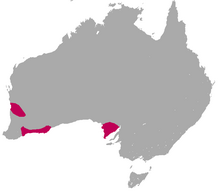| Broad-faced potoroo[1] | |
|---|---|

| |
| Stuffed specimen at the Natural History Museum Pisa | |
| Scientific classification | |
| Domain: | Eukaryota |
| Kingdom: | Animalia |
| Phylum: | Chordata |
| Class: | Mammalia |
| Infraclass: | Marsupialia |
| Order: | Diprotodontia |
| Family: | Potoroidae |
| Genus: | Potorous |
| Species: | †P. platyops
|
| Binomial name | |
| †Potorous platyops | |

| |
The broad-faced potoroo (Potorous platyops) is an extinct potoroid marsupial that was found in southwestern Australia. The first specimen was collected in 1839, and described by John Gould in 1844. Only a small number of specimens have been collected since. The last live capture was in 1875. Subfossil remains indicate that it had an extensive distribution around the semiarid coastal districts of Southwest Australia.
The habitat of the broad-faced potoroo is almost entirely unknown, but unlike its relatives, such as the long-nosed potoroo Potorous tridactylus and long-footed Potorous longipes, they do not seem to have lived in dense understories in forests. Preserved specimens indicate that it was smaller than other potoroos at around 300 mm (1 ft) long with a 180-mm tail. Their weight is estimated at 800 g. Their coat was grizzled with yellowish hairs above and greyish white below. Their body was similar in shape to that of other potoroids. Their ears were small and rounded, muzzle fairly short, and cheeks notably puffy.
- ^ Cite error: The named reference
MSW3was invoked but never defined (see the help page). - ^ Burbidge, A.A.; Woinarski, J. (2016). "Potorous platyops". IUCN Red List of Threatened Species. 2016: e.T18103A21960570. doi:10.2305/IUCN.UK.2016-2.RLTS.T18103A21960570.en. Retrieved 13 November 2021.
- ^ Cite error: The named reference
Gould1844was invoked but never defined (see the help page).
